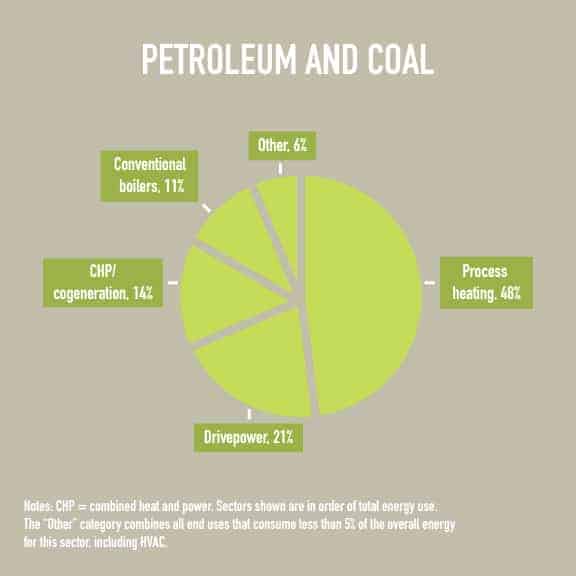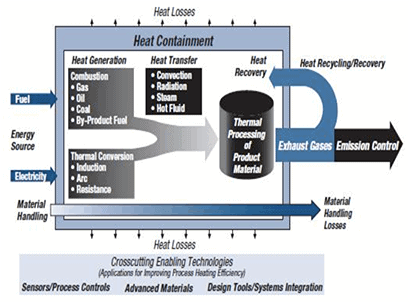Within the petroleum and coal industry, there are four main energy consumers: Conventional boilers, CHP/ cogeneration, process heating and drivepower. Although manufacturing is largely considered one industry, once broken down, there are actually many types of manufacturing that have differing energy needs.

1. Conventional Boilers
Boilers are used to create high pressured steam in power plants that then generate electricity. This is known as the Rankine cycle. The boiler takes energy from a source of fuel, in this case petroleum or coal, and turns it into steam. How the boiler is designed is very important when determining the power plant’s efficiency. The fuel-to-steam efficiency measures how many thousands of tonnes of steam per hour can be produced. Many steam-producing boilers run at a fuel-to-steam efficiency as high as 90%. The better the design of the boiler, the lower the fuel requirement and less pollutants emmitted. Although boilers are very efficient, they contribute to some of the world’s major pollution issues through the emittance of greenhouse gases.
2. Process Heating
Heaters are used in the petroleum and coal manufacturing industry for various purposes. Although each heater has slightly different components, they all transfer heat energy to the material that has to be treated. Direct methods focus on generating energy within the material itself, whereas indirect techniques transfer heat to the material from another source using radiation, convention, conduction or any combination of the three.

Most process heaters have an enclosure that is used for isolating the environment from the system. The reason for this is it restricts radiation within the boundaries of a system, confines the combustion of different products, and ensures the surrounding atmosphere is controlled. The figure above details the most essential components of a typical process heater.
3. CHP / Cogeneration
Combined heat and power (CHP) is the simultaneous cogeneration of electricity and heat. One of the most efficient forms of energy conversions is cogeneration, which uses gas engines and can achieve primary energy savings of around 40% compared to purchasing electricity from the grid. When fuel for a gas engine is renewable, such as hydrogen, biogas, or biomethane, CHP can be an extremely sustainable option for electricity and heat. Within the manufacturing industry, combined heat and power plants are typically embedded near to the end user, which helps to reduce transportation and distribution losses. This tends to improve the overall performance of the electricity transmission within a distribution network.
4. Drivepower
Drivepower refers to the power being used to run systems such as motors, hydraulics, etc. It converts electrical or hydraulic power into mechanical motion (typically rotary) to drive a mechanical actuation system. Within the petroleum and coal industry, drivepower is often required for the machinery used during extraction.

The graph above illustrates the process of a drive power unit and how it converts electrical or hydraulic power into mechanical motion.






